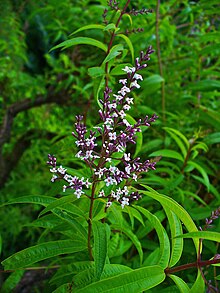Aloysia citrodora
| Aloysia citrodora | |
|---|---|
 |
|
| Scientific classification | |
| Kingdom: | Plantae |
| Clade: | Angiosperms |
| Clade: | Eudicots |
| Clade: | Asterids |
| Order: | Lamiales |
| Family: | Verbenaceae |
| Genus: | Aloysia |
| Species: | A. citrodora |
| Binomial name | |
|
Aloysia citrodora Paláu |
|
| Synonyms | |
|
Aloysia triphylla (L'Hér.) Britton |
|
Aloysia triphylla (L'Hér.) Britton
Lippia citriodora Kunth
Lippia triphylla (L'Hér.) Kuntze
Verbena triphylla L'Hér.
Zappania citrodora Lam.
Aloysia citrodora is a species of flowering plant in the verbena family Verbenaceae, native to western South America. Common names include lemon verbena and lemon beebrush. It was brought to Europe by the Spanish and the Portuguese in the 17th century and cultivated for its oil.
Lemon verbena is a perennial shrub or subshrub growing to 2–3 m high. The 8-cm-long, glossy, pointed leaves are slightly rough to the touch and emit a powerful scent reminiscent of lemon when bruised (hence the Latin specific epithet citrodora—lemon-scented).
Sprays of tiny purple or white flowers appear in late spring or early summer. It is sensitive to cold, losing leaves at temperatures below 0 °C (32 °F), although the wood is hardy to −10 °C (14 °F). Due to its many culinary uses, it is widely listed and marketed as a plant for the herb garden.
Lemon verbena leaves are used to add a lemon flavor to fish and poultry dishes, vegetable marinades, salad dressings, jams, puddings, Greek yogurt and beverages. It also is used to make herbal teas, or added to standard tea in place of actual lemon (as is common with Moroccan tea). It can also be used to make a sorbet. In addition, it has anti-Candida albicans activity. In the European Union, Verbena essential oils (Lippia citriodora Kunth.) and derivatives other than absolute are prohibited when used as a fragrance ingredient (Commission Directive 2009/164/EU of 22 December 2009).
...
Wikipedia
